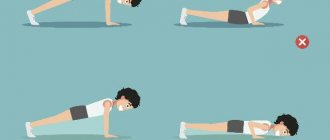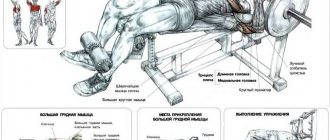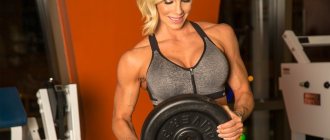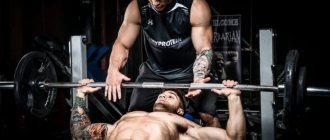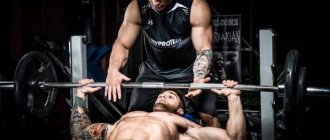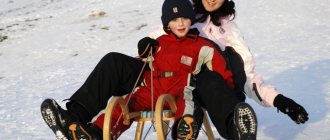The most adequate approach to studying training methods in any sport is to process the maximum amount of literature on the specifics and physiology of a particular sport. If we consider the training methods of ski racers, we can understand that they are generally similar to other sports where endurance plays a decisive role, but there are very important details that make the training of ski racers quite fundamentally different in comparison with other sports.
The physiology of cross-country skiing is the subject of repeated research, most of which took place in Europe and Scandinavia, where this sport is most widespread. Where should you start studying the physiology of cross-country skiing? Of course, from the portrait of a champion skier.
Physiological portrait of a cross-country skier
The average age of a ski racer at the peak of his career is 27-29 years. Deviations of 4 years in each direction are possible; most of the Olympic medalists in the cross-country skiing discipline are people aged 20 to 30 years. In cross-country skiing, results are impossible without training, and victories are not given due to the starting physiological data, as evidenced by the fact that there have never been juniors among the medalists of the Olympics and World Championships.
Body type of a professional ski racer
What can you say about the physique of a ski racer? The fact that there is no average or exemplary body type. As an example, we can consider several other sports where endurance plays a key role: all champion long-distance runners look like clones (thin, tall, with the same proportions of limbs), long-distance swimmers look fundamentally different, but from each other are also extremely similar (they are an order of magnitude larger than runners, shorter, and have very developed muscles of the upper body). A professional cross-country skier can be between 1.65m and 2m tall and often have a small amount of body fat (for the most part they cannot be called thin, the most appropriate definition is an athletic build).
Muscle structure of a ski racer
The composition of the thigh muscles is important for our study. In an average person, the composition of muscle fibers is in the ratio of 50% fast fibers (IIa and IIb) and 50% slow fibers. Professional racing skiers have a completely different ratio - from 62 to 75% slow fibers, and the rest are type IIa fibers. In their pure form, type IIb fibers are practically absent in the skier’s muscles.
Why is this happening? The answer is very simple - IIb fibers are transformed into IIa, which, although fast, have a high resistance to fatigue and are better suited for long-term loads. The most interesting thing is that similar studies conducted among professional runners and cyclists revealed a far from significant shift in the ratio of structural muscle elements - they did not differ so much from the standard ratio of 50-50 fast and slow fibers. What could be the reason? The reason is the heterogeneity of the load: firstly, cross-country skiing traditionally involves varied terrain; secondly, in cross-country skiing the muscles of the whole body work, including the load on the shoulder girdle (latissimus dorsi, deltoids and triceps).
How to increase your skiing speed? Optimal range of motion
The speed of movement in cross-country skiing depends on the frequency and length of the step. Increasing the frequency of steps without decreasing their length gives greater speed. The reverse is also true: longer steps at the same frequency give more speed.
A good rider tries to take as many and long steps as possible, both in skating and in classic variable speed. An important tactical advantage is the use of inertia, and in some situations, coasting movement. It is interesting to observe the movement technique of professional skiers, because you can see very interesting features, for example, the extension of the arm at the beginning of the push with the arms, which gives additional inertia to the movement.
Related material: How Olympic biathlon champions train
The average speed at the World Cup is 6-7 m/s depending on the conditions. Interestingly, racing skiers move differently depending on the distance. Moreover, this dependence is not always linear.
The best marathon runners run at an average speed that is 20% lower than the 5,000m ski racer. The difference in movement between a 50K racer and a 10K racer is only 5-7%. The reason is in the method of movement + in long-distance races they try to select routes with less elevation difference. An interesting fact is also that the average speed of women on the same tracks is 14-15% lower than that of men.
The average speed of a skier is also affected by the level of glycogen in the body. This substance precisely affects the production of energy at high intensity of the body’s work. We discussed this issue in detail in our article about the intensity of training for cross-country skiers.
Author's trekking course in mountainous Dagestan
Course idea. The trails of Dagestan are ideal for trekking. Laid through alpine and subalpine zones back in the days of the Great Silk Road, they go from village to village along centuries-polished trajectories, away from roads, through safe passes, between glaciers and four-thousand-meter peaks. Almost everywhere along the trails there is drinking water and, at the end of the day, a place for a tent. There are places for day trips, with radial exits to panoramic points and nearby peaks. Along the route it is possible to visit the high mountain villages of the region.
In the distance is the city of Addala-Shukhgelmeer (4152), the third highest mountain in Dagestan. Photo by the author. Route No. 7, July.
Course idea | Who are we inviting? Can I handle it? | What are we teaching? | Security | Routes and their Budget | Dates | Cargo. Equipment. Nutrition. | Base. Accommodation. | Weather | Communication | Rest after the hike | Head Instructor | Contacts | More photos | Questions and discussion | Sign up
Maximum oxygen consumption and athlete performance in cross-country skiing
What does a high maximum oxygen consumption (VO2) provide? Producing energy, which is very important for cross-country skiing. The higher this indicator, the better. When measuring BMD, it is very important to take body weight into account. Some athletes calculate absolute VO2 max values, but we prefer to calculate more precise parameters measured in milliliters per minute per kilogram of body weight (ml/min/kg).
For understanding, let's take 2 clear examples. Skier No. 1 weighs 70 kg, and his absolute value of MOC = 6 l/min. Skier No. 2 weighs 80 kg, and his absolute VO2 max is 6.5 l/min. And it seems obvious that the second one works more efficiently, but let’s remember our calculation method... Skier No. 1 in this case will have an indicator of 85 ml/min/kg, and No. 2 81 ml/min/kg. In addition, the additional body mass will work against the skier on the climb (more energy will be needed). Someone will say that additional weight will also give inertia on descents... And they will be right! But it all depends on the specific conditions of the track.
According to the IPC, a clear and precise conclusion can be drawn: the higher the indicator, the better. Look at the best ski teams in professional competitions - most of them have athletes with the highest VO2 max.
However, MOC has a completely natural limiter - the operating mode of the heart. For professional ski racers, the heart works in a completely special way, but this is a topic for a separate article.
Alexander Legkov's favorite exercises for the core muscles
Bicycle with a small range of motion
Execution technique
- We lie down on our backs. We put our hands on the belt. There should be no arching in the back.
- Lift your straight legs off the floor. The distance between your feet and the floor should be small.
- We begin to take small “steps” with our feet. Oscillations of the legs should be with minimal amplitude.
- If this option is difficult to do, you can bend your legs and pull them higher towards you.
We do the exercise for one minute and 15 seconds, rest for 15 seconds.
Bicycle with palm touching heel
Execution technique
- We lie down on our backs. Lift your straight legs off the floor.
- Bend your right knee, pulling it towards your chest. At the same time, we touch the right heel with our left palm. The right arm is straightened and stretches diagonally to the side. Be sure to direct your gaze behind the outstretched hand.
- We do the same with the left leg and right arm.
We perform the exercise for one minute and 15 seconds, rest for 15 seconds.
Side plank
Execution technique
- We lie down on the mat on our right side. Bend your right arm at the elbow, place your left arm on your belt, legs together.
- Raise the body. The body and legs should be one straight line.
- If preparation allows, the left arm can be extended upward and the body can be rocked up and down. You can also swing with your left leg.
- We change sides and repeat everything from the beginning.
To make it more challenging, you can put your feet on a sports ball and do the same thing on it.
We do the exercise for one minute and 15 seconds, rest for 15 seconds.
Advanced plank on the ball
Execution technique
- We lie down on our stomachs. The arms are bent at the elbows. We place our feet on a sports ball.
- The body and legs form a straight line. The pelvis should not be raised too high or lowered too low.
- We fix ourselves in this position and stand.
To complicate the exercise, you can pull your left and right legs towards you alternately.
We do the exercise for one minute and 15 seconds, rest for 15 seconds.
Work of the upper shoulder girdle in cross-country skiers
Obviously, working the upper shoulder girdle is very important for cross-country skiing. How much? The upper shoulder girdle gives from a 10% increase in speed with a classic alternating stroke to 100% with a simultaneous stepless stroke. When lifting with a skate, the upper shoulder girdle forms up to 50% of the total effort. Surprisingly, just try to go the distance without using any upper body movement.
As for the MIC of the muscles of the shoulder girdle, a very clear picture is visible - among skiers this indicator is quite high. For the average person, the peak MOC reaches up to 60% of the maximum, for amateur skiers up to 75%, for professional ski racers from 80 to 90%, in some cases this figure reached 95% of the maximum. Obviously, in order to comprehensively improve the results of cross-country skiers, it is necessary to include in the training plan exercises to strengthen the muscles of the upper shoulder girdle, as well as increase their VO2 max.
But what about speed qualities?
The answer is simple: take part in cross-country competitions, triathlons, swimming competitions or roller skating! But there is no need to prepare specifically for these competitions in the summer.
As an example, a weekly training plan during the preparatory period , used by a whole generation of leading Russian athletes, racers and biathletes. You can't just copy this plan. Take a look and decide for yourself: how and when you can use such an idea in your conditions!
Monday:
1 Calm jogging or rollerblading for up to 2 hours. 2. Special strength endurance (rollers or multi-jumps) - 1 hour.
Tuesday:
1. Long roller skating or simulated running with poles for 2 hours (Hard training!).
2. Recovery training – running for 45 minutes.
Wednesday:
1. Strength training - 2 hours.
Thursday:
1. Strength training for endurance - 1 hour.
Friday:
1. Special strength (running with poles and imitation of climbs or only on the hands of rollers or rollers without poles with a skate) 2 hours (Hard training!)
2. Unloading light training - bike 1 hour or kayak.
Saturday:
1. Long training - 3.5 hours (cross-hike, bike)
What else is important when training cross-country skiers?
Important parameters that are also worth training are the lactate threshold and efficiency of movements. Both are important, because cross-country skiing is a very specific load on the body, unlike any other sport, and the movement technique of the skier-racer is constantly changing.
We did a separate article about lactate: what is lactate and how to measure it?
If we talk about the economy of movements, then it is worth pointing out that there can be several techniques for the movement of a skier-racer only on the plain: alternately two-step move, simultaneously one-step, simultaneously stepless, simultaneously two-step skating, simultaneously one-step skating, two-step with swings and without swinging arms, but there are also ups and downs, on which the skier can also use several movement options. We will publish a separate article about the most effective approaches to the economy of movements and the use of certain methods to get from point A to point B in cross-country skiing.
Autumn: October - November
To get off to a successful start in winter, you need a little rest in the fall.
Imitations must be done before October. With the arrival of deep autumn, interval training takes on a softer character and is aimed more at developing technique and preparing for a ski-specific load. This is where roller skis will help us a lot. Quick training on roller skis should serve to test our equipment in “combat” conditions. Tempo training is more suitable for this than interval training. It is better to either make strength exercises more specific or eliminate them. Approximate plan: Mon: rest Tue: cross-country or roller skiing, slow 40-60 minutes Wed: interval or tempo training 30-60 minutes (excluding warm-up and cool-down) Thu: rest Fri: cross-country slow 20-40 minutes + technique exercises Sat : tempo training on roller skis, testing equipment in competitive conditions Sun: cross-country or roller skis, slow 60-90 minutes

